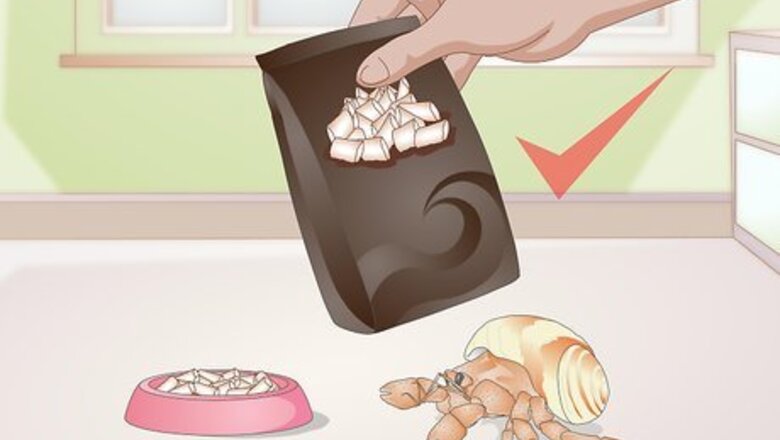
views
- Hermit crabs can eat a variety of different foods, like commercial crab food, veggies, fruits, wood, and even treats, like peanut butter.
- To keep your hermit crabs healthy, feed them at night and use a shallow dish for easy access.
- Fill a shallow dish with dechlorinated water so your hermit can drink throughout the day.
Feeding Your New Crab
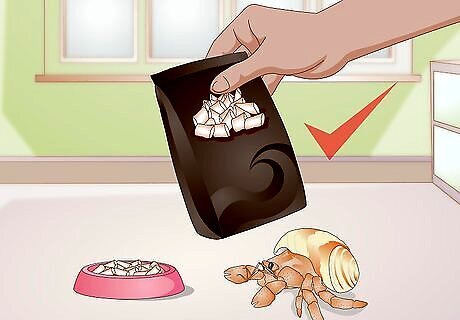
Choose a high-quality commercial crab food. There are several varieties of commercial crab food available that you can use as the basis for your crab’s diet. What’s more, you can alternate between these and provide your crab with a well-balanced diet. Hermit crab food is available in pellet form, in gel form, in powder form, or like canned dog food. If you choose any of these types of food, give small crabs about 1 teaspoon per day. Generally, all forms contain many nutrients not found in every human food, like tannins, carotenoids, and cellulose, to name a few. There is some conflict over whether or not to feed your crab commercial crab food. However, the consensus is that organic food is better than non-organic, and that you should avoid buying commercial food that has copper sulfate or ethoxyquin.
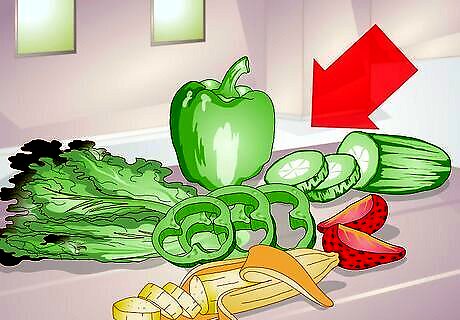
Pick different colored and textured vegetables. Hermit crabs not only love vegetables and fruits, they are able to consume a wide variety of them. You should change up the menu by rotating between kale, broccoli, bananas, and any other safe fruit or veggie, like mangoes, papaya, and coconut. This will help keep your crab from getting bored with the same old food, in addition to providing a well-balanced amount of the vitamins and minerals found in different veggies. You can serve vegetables raw as long as you rinse them thoroughly in water (without soap!). Some believe it is important to note that the main source of nutrition should be from a commercial crab food, with vegetables and fruits being added only as a supplemental treat.
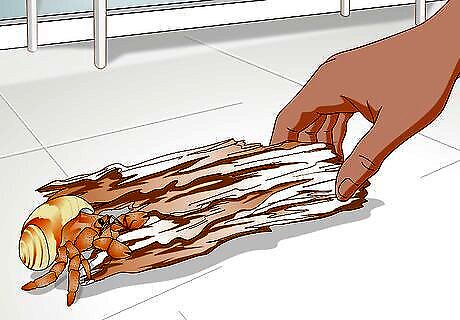
Provide wood for your crab. Crabs love wood because they can play on it and they also enjoy eating it. A positive feature of wood is that it lasts longer and does not have to be replaced daily. It is also abundantly available right outside your front door. There are several types of wood for their enjoyment, like Birch, Oak, Ash, or Cholla, to name a few. Your crab is a little creature, so there is no need to feed them multiple times a day. Feed your crab once daily in order to keep the fruits and veggies fresh. Foods like wood will last considerably longer, so change the wood when you see it gets slimy, old, or otherwise unappetizing.
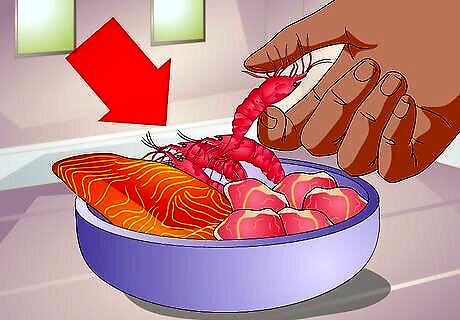
Give them enough protein. Many new crab owners neglect to provide an adequate protein source or variety. Protein is important for maintaining a crab’s musculature, exoskeleton, and also for aiding in the processing of carbohydrates. More protein makes for a stronger crab. You can select from a wide range of widely available protein sources like animal protein (turkey, unseasoned beef, duck), seafood (lobster, catfish, cuttlefish), or grubs (bloodworms, earthworms). You can even source some of these from your own yard (just dig up some worms after a fresh rain). You should include a fresh protein source on a daily basis. Fresh in this case means that each day you’ll need to provide new food, replacing the old protein. The protein sources you serve can be raw or cooked, including meat. Crabs do enjoy eating meat off of the bone, but they do not do well with sauces or butter. Make sure to exclude these. Seafood can also be served raw or steamed.
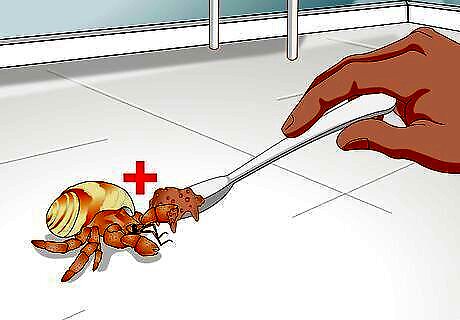
Give your crab treats. Just because protein is essential for your hermit’s diet, it doesn’t mean you can’t treat the little fella from time to time. Aside from fruits and veggies, you can give your crab a little peanut butter as a treat. Just be sure to look at the ingredients so you can avoid extra sugars and other unwanted items. Natural peanut butter will be best. Honey, washed grass, trail mix, and popcorn are other favorable treats.
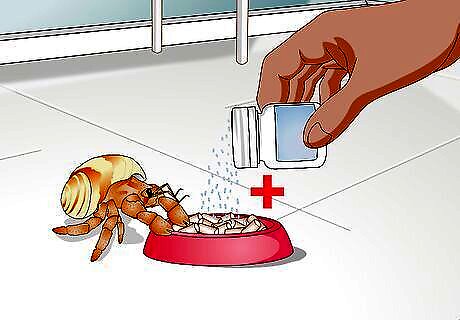
Supplement your crab’s food with calcium. While hermit crabs are omnivorous and eat just about anything, they may be some extra attention when it comes to ensuring they have a complete diet. It’s important to supplement their food with calcium source. Give them calci-sand substrate, crushed oyster shell, or cuttlebones. Each of these is calcium rich, which will help shell maintenance and exoskeleton development. Neglecting this could lead to an unhealthy crab.
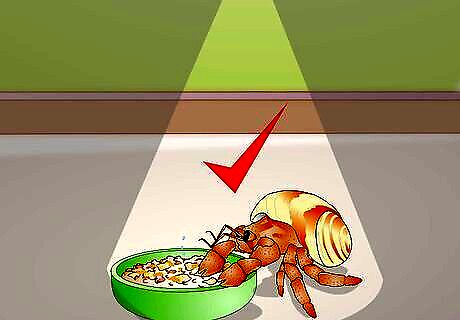
Feed your crab at night. Crabs are nocturnal so feed at night or in the evening. If you have trouble remembering, you can always set a timer. Better yet, make feeding time a part of your daily routine. It’s strongly recommended that you remove the meat and seafood the following morning to avoid attracting flies and other pests.
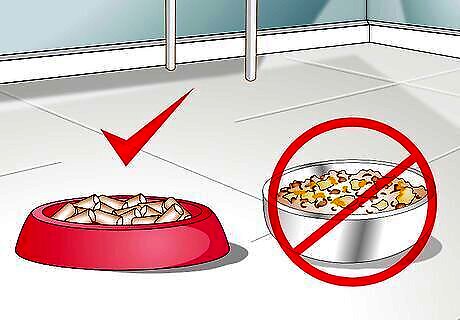
Use shallow dishes. The dishes you choose will have a great impact on your crab’s well being. Taller dishes won't allow your crabs to freely access their food. The optimal height for a food dish is one that is shallow. Crabs are also sensitive to metals. Make sure you choose dishes made of plastic or ceramic. The best type of dish will also be non-porous. The tiny imperfections in porous materials (stone, some plastics) permit the growth of bacteria and germs.
Controlling Your Crab’s Environment
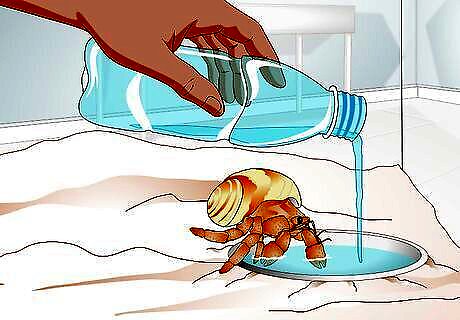
Give your crab water. Your little friend will need a place to drink, bathe, and play. Put a shallow dish a fresh water in the enclosure daily. Your crab will decide when and what quantity to drink. You’ll need to treat any tap or bottled water with a water dechlorinator. This is crucial because hermit crabs are sensitive to chlorine and chloramines (a combination of chlorine and ammonia that affects their gills). If you have an Ecuadorian hermit crab (land crab), give it one bowl of fresh water and one bowl of salt water. These crabs require both types of water to keep their gills wet (yes, crabs have gills!). Without both salt and fresh water the gills dry out and the crab suffocates.
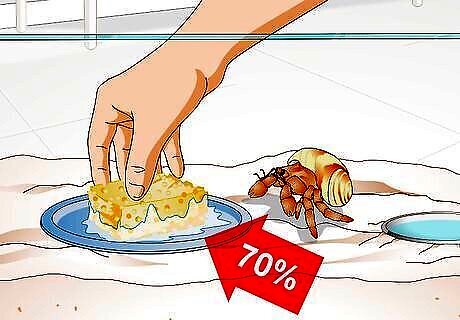
Control the humidity level. The amount of moisture in the air directly affects the health of your tiny crab, so keep an eye on it. You should strive to maintain a level of about 70% humidity in your crab’s home. Keeping the environment humid only requires that you place a natural sponge inside of a dish of water in the enclosure, which helps disperse the moisture. Be sure to place the sponge in close proximity to the tank heater. This will ensure the water evaporates from the sponge.
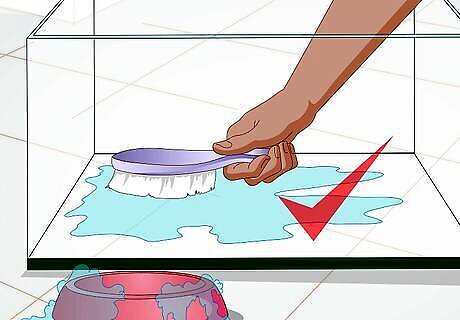
Clean your crab’s enclosure. Make sure you keep on top of cleaning your crab’s enclosure, including the dishes. You may notice a residue or film on the water dish. Even though this is a common, natural occurrence, you need to clean it off regularly. As an additional note, when you change the water, also clean other undesirables from crabitat, like crab feces. This will help reduce water contamination, as well as cut down on any odiferous emanations from the crab’s home.




















Comments
0 comment